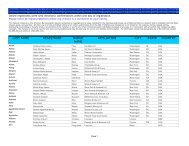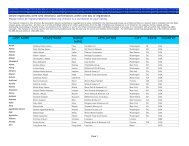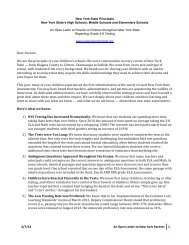Final_CA_Drought_Contingency_Plan-11-18-2010a
Final_CA_Drought_Contingency_Plan-11-18-2010a
Final_CA_Drought_Contingency_Plan-11-18-2010a
You also want an ePaper? Increase the reach of your titles
YUMPU automatically turns print PDFs into web optimized ePapers that Google loves.
California <strong>Drought</strong> <strong>Contingency</strong> <strong>Plan</strong>Recycled Municipal WaterIn 2009, DWR developed dual plumbing standards, in consultation with the CaliforniaDepartment of Public Health and other agencies, to safely plumb certain buildings andcommercial properties with both potable and recycled water systems. On November <strong>18</strong>,2009, the Building Standards Commission unanimously voted to approve the CaliforniaDual Plumbing Code and building codes were codified in January 2010. The code waspublished on July 4, 2010 which began the statutory <strong>18</strong>0-day period between publishingand the effective date of the code. The Dual Plumbing Code effective date is January<strong>11</strong>, 20<strong>11</strong>.In May 2009, the State Water Resources Control Board adopted the Recycled WaterPolicy (Recycled Policy) which is intended to support their Strategic <strong>Plan</strong> priority ofpromoting sustainable local water supplies. Increasing the acceptance and promotingthe use of recycled water is a means towards achieving sustainable local water suppliesand can result in reduction in greenhouse gases by reducing some of the need forimported water, a significant driver of climate change. The Recycled Policy is alsointended to encourage beneficial use of, rather than solely disposal of, recycled water.To the extent water recycling provides additional water supply it provides additionalresilience to drought.In July 2009, the State Water Resources Control Board adopted General WasteDischarge Requirements for Landscape Irrigation Uses of Municipal Recycled Water(General Permit). The Landscape General Permit is consistent with the HRecycled WaterPolicyH, State and Federal water quality laws, including the statewide water qualitystandards established by the California Department of Public Health. The GeneralPermit facilitates the streamlining of the permitting process to reduce the overall costsnormally incurred by producer, distributors, and users of recycled water.See website (www.water.ca.gov/recycling/) for more information on the water recyclingand the California Water <strong>Plan</strong> Update 2009, Volume 2, Chapter <strong>11</strong> Recycled WaterManagement Resource Management Strategy.Surface Storage – <strong>CA</strong>LFEDThe <strong>CA</strong>LFED Record of Decision (2000) identified five potential surface storagereservoirs that are being investigated by the California Department of Water Resources,US Bureau of Reclamation, and local water interests.• Shasta Lake Water Resources Investigation (SLWRI)• North-of-the-Delta Offstream Storage (NODOS)• In-Delta Storage Project (IDSP)• Los Vaqueros Reservoir Expansion (LVE)• Upper San Joaquin River Basin Storage Investigation (USJRBSI)California’s water resources future has become increasingly uncertain. Consequently,these proposed projects would need to perform well under a number of potential future15






